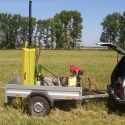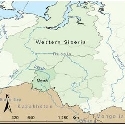06 Aug 2012
Improvement of Diagnosis Accuracy of Phosphate Status for Ukrainian Soils
By Anatoly Khristenko and Svetlana Ivanova
Studies performed at the Institute for Soil Science and Agrochemistry Research named after O.N. Sokolovsky, National Academy of Agrarian Science, Ukraine, show that some chemical methods used for the determination of plant available elements involve large errors. In particular, the error for determining available soil P or K based on former Soviet Union soil testing standards can reach 100 to 200% or more. Most methods include the use of strong acid solutions that can underestimate results for all coarse (sandy and loamy sandy) soils, as well as for strongly acid (pHKCl < 4.5) soils of different textures, and can overestimate results for soils with high contents of primary P-containing apatite minerals. Presently eight national soil test standards and five standard drafts have been developed for Ukraine’s 32 million ha of arable land. The process began with the identification of Ukrainian regions and soil types for which specific chemical methods of determining plant available N, P, and K are most advisable. The potential effects of soil composition and physical properties on the results of chemical analyses were taken into consideration. New scales of soil supply for available P or exchangeable K were developed for some methods that together specify methods for determining plant available N, P, and K for all soils of the country.
The use of State standards, including the Olsen, Machigin, Chirikov, Kirsanov, and Karpinskii–Zamyatina methods (described below), has generally meant that available P status of arable soils under extensive agricultural use fall within the lowtomedium supply levels, while available K status is generally considered medium. This agrees with well-known empirical data that demonstrates high efficiency of mineral fertilizers, especially P fertilizers, on all types of arable soils of Ukraine, including its chernozems. New regulatory soil tests explained below, demonstrate an increase in accuracy of the diagnosis of soil fertility. The subsequent correction of fertilizer application rates, and more rational distribution of fertilizers among fields and crops, can increase use efficiency by an average of 30%. Errors in soil testing theory and methodology create overestimation (or underestimation) of results for not only individual fields, but also entire regions. An illusion of rich chernozems on loessial rocks is related to the increased content of P-bearing apatites and K-bearing feldspars in these soils. However, P or
K present in these minerals are not directly available to plants. At the same time, these elements are partially extracted by strong acid solutions, including 0.02 N HCl (pH 1.0, Kirsanov method) and 0.5 N CH3COOH (pH 2.5, Chirikov method).
Reported data shows that the unbiased assessment of soil fertility and available forms of macro- and micronutrient is a global challenge.
Shortcomings of the methods based on the use of acid solutions are largely typical for all methods using extractant solutions with pH below 4.5: Bray–Kurtz 2 (pH 1.0), Mehlich 1 (pH 1.2), Arrhenius (pH 2.0), Mehlich 3 (pH 2.5), Mehlich 2 (pH 2.6), Van Lierop (Kelowna, pH 2.7), Egner–Riehm (pH 3.6), Bray–Kurtz 1 (pH 3.5), Egner–Riehm–Domingo (pH 4.2), etc. For example, we found that the determination of P by the Egner–Riehm method in soils with strongly acid or alkaline reaction entails the underestimation of the results (Figure 1).
An increase in the content of apatite in the soil, on the contrary, overestimates the results. The content of apatite is reflected in the Ca–P fraction (i.e. Chang–Jackson method). The tendency toward a “decrease” in the content of P in soils with the very high content of apatite (prevalent in the Ukrainian steppes) is related to their alkaline reaction. The authors evaluated this through a combination of methods based on different principles: chemical methods, ion-exchange chromatography, and pot studies. A statistical analysis of data from an automated information data bank (more than 1,500 soil samples) was also performed. On the basis of these studies, a conclusion was drawn about the advisability of the wide use of so-called “mild” methods (based on the use of salt and weakly alkaline extractant solutions).
A 30-year-long comparative study of different methods showed the superiority of the method based on the use of a sodium bicarbonate solution (Olsen et al., 1954). It was found that the particle-size distribution and other soil properties (e.g. presence of apatite, acid reaction) had almost no effect on the Olsen method’s results. The coefficient of correlation was r < 0.33. The content of available P in the Ukraine’s unfertilized and underfertilized soils, as determined by the acid method, can vary from very low to very high values of P supply (Table 1). According to the Olsen method, Ukrainian soils always are within the low-to-medium P supply range. Data obtained by the Olsen method for acid and neutral soils always agree with the soil fertility estimated using other mild methods. The adequacy of the P status estimation was also confirmed by pot study (Table 2).
The authors propose refined P sufficiency ranges, as determined by the Olsen method, which now coincide with estimates of soil P supply from other mild chemical methods (Machigin, pH 9.0; Chang–Jackson, Al–P fraction, pH 8.5; Karpinskii–Zamyatina, pH 5.8). A category of very high supply was also added in hopes of further contributing to the more rational use of the resources available. Optimum plant available P for stable, high crop yields lies within the range
corresponding to high P supply. An increase above the optimum level results in an abrupt decrease in crop response to P fertilizer. Liberal application of P fertilizers to highly alkaline soils is also unadvisable as high alkalinity (pHKCl 8.0 or pHwater 8.5 and higher) is frequently due not only to the presence of calcium carbonates, but also to the presence of Na. The latter compound is detrimental to the growth and development of many agricultural crops, which abruptly decreases the efficiency of fertilizers applied.
Mathematical models and the corresponding software were developed by the authors for the determination of the actual supply of alkaline soils with available P depending on the pHKCl or pHwater values (Khristenko, 2009). The use of these mathematical models or software, as well as the improved scale for soil P supply, will contribute to the optimization of fertilizing systems and, hence, expenditures per ha of fertilized area. For example, finding that the supply of soil P is 25 mg P2O5/kg (medium P supply) rather than 5 mg P2O5/kg (low P supply), the farmer can significantly reduce fertilizer application without fear of crop yield reductions.
References
Agrochemical Methods of Soil Examination. 1975. In A.V. Sokolov (Ed)., Moscow: Nauka, 1975, p. 106-190.
Khristenko, A.A. 2009. Utility Patent No. 41725 Ukraine, MPK (2009) G01N 33/24 // Byull. Izobr. No. 11
Olsen, R., C.V. Cole, F.S. Watanabe, and L.A. Dean. 1954. U.S. Dept of Agric. Cir. 939.
Yanishevskii, P.F. 1996. Agrokhimiya, No. 4:95-116.
Скачать материалы:
Improvement of Diagnosis Accuracy of Phosphate Status for Ukrainian SoilsSize: ,39 MB




